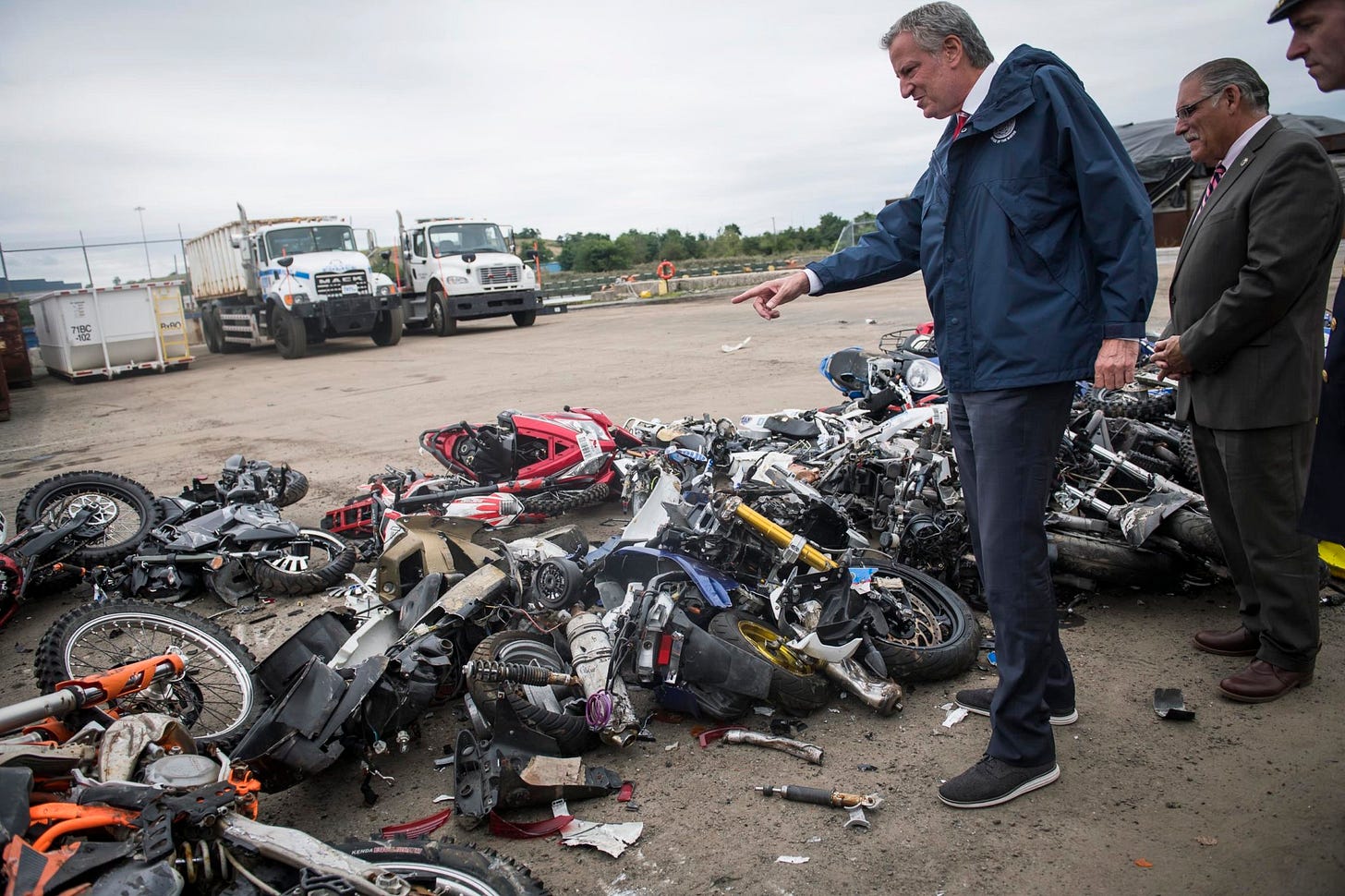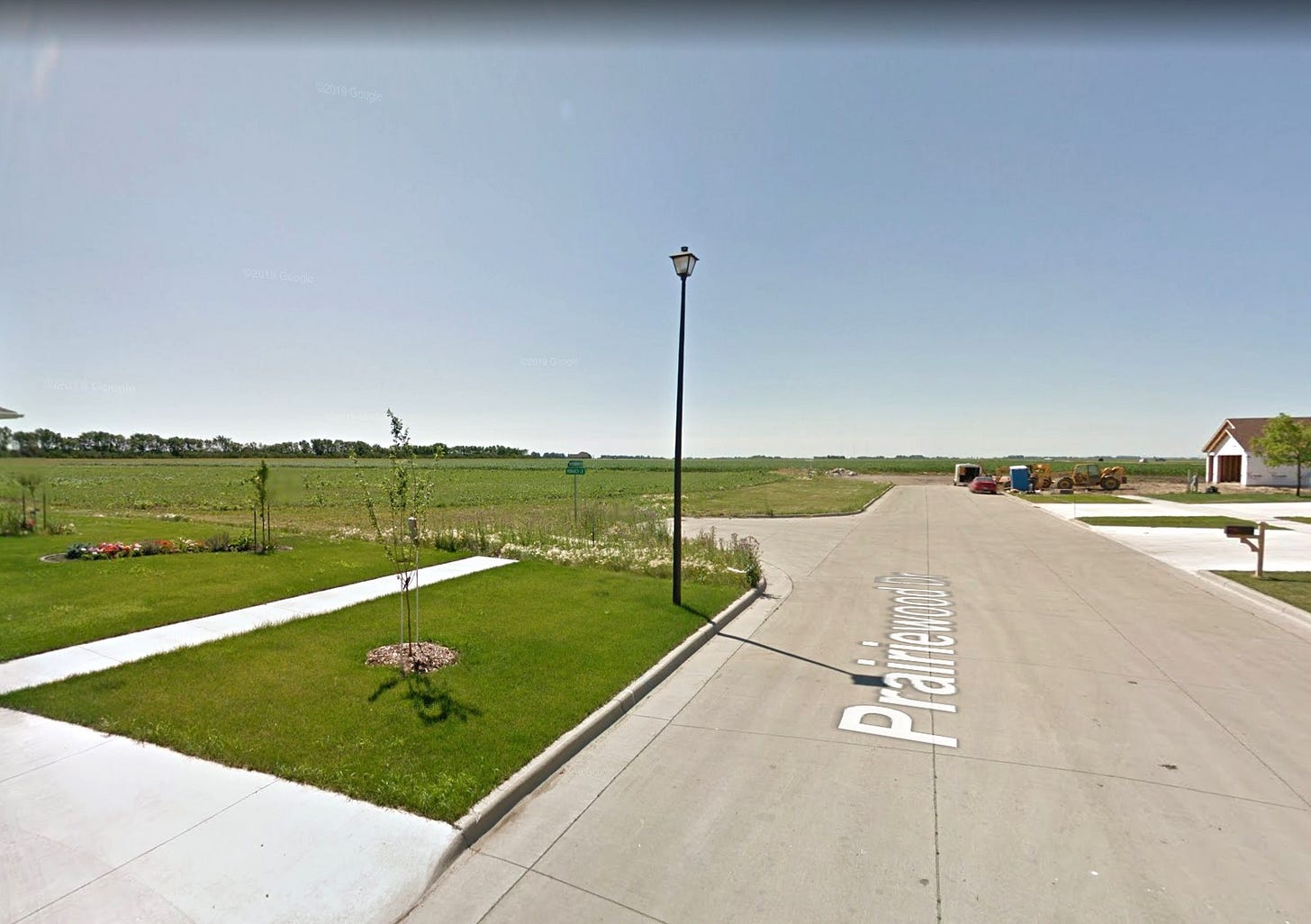“Let’s. Crush. Some. Dirt bikes!!!!” the mayor of New York tweeted. Bill de Blasio did not mean "crush" in the positive, slangy sense. The attached livestream, which happened last week, was of the city literally crushing “about 50 bikes seized by police over the last few months,” with a bulldozer. (“Dirt bike" is supposed to mean a small motorcycle intended for off-road use, though in practice it's often used to describe many types of small motorcycles that aren't equipped with the signals and lights that make larger motorcycles street legal. The haul also seemed to include some four-wheeled all-terrain vehicles.) De Blasio followed that up with an edited highlight reel of the destruction (and, in truth, while most of the vehicles were wrecked, none were satisfactorily flattened, like Judge Doom in Roger Rabbit).
The mayor's gleeful tone revealed the point of the spectacle. We, his constituents, were meant to understand that the mayor was both Getting Things Done and Having a Ball. An elected official whose favorite activities, for most of his tenure, seemed to consist mainly of showing up late for press conferences and aimlessly ambling through Prospect Park has spent much of this year holding events around the city, doing things like riding the Cyclone roller coaster and even attending the Met Gala (precisely the sort of rich Manhattan thing he'd pointedly avoided for years, out of his own warped vision of liberal populism). This has all been part of a campaign to convince New Yorkers that our term-limited and thoroughly checked-out mayor is finally having fun and, you know, governing. Judging by the online response, many people did indeed enjoy the dirt bike destruction—though, like so many de Blasio press stunts, it suffered from the fact that the majority of its intended audience deeply hates him (and mostly not even for the right reasons).
I grant that the dirt bikes are a problem. I live in a Brooklyn neighborhood where young people aggressively driving dirt bikes are a regular sight, and mostly an unwelcome one, though they are not exactly my most pressing quality-of-life concern. The bikes are loud and the riders are reckless. Worst of all (to me at least) most of these bikes are major polluters with terribly inefficient engines.
(Much of this is also true of commercial trucks with oversized trailers, which are just as illegal as dirt bikes on New York streets, almost certainly even more common, and definitely more of a threat to city residents. The city has, for some reason, not yet attempted to seize and destroy any on camera, even though that would be much cooler.)
One funny story is that California attempted, years ago, to regulate dirt bikes to become cleaner, but by inventing a category of bike exempted from those rules—supposedly for “competition,” though nearly all of them are just ridden recreationally—they mainly just ended up boosting the sales of the cheaper and dirtier exempted bikes. The exhaust emissions of these dirtier dirt bikes are ridiculous, too. According to the California Air Resources Board, the hydrocarbon emissions from riding a motorcycle with a two-stroke engine one mile are equivalent to a passenger car driving 3,600 miles. That, more than anything else, is why we should get these bikes off our streets.
So: The dirt bike problem is real. What is the solution?
One thing a city could do is have its police department steal a few hundred of these bikes and have bulldozers run over some of those stolen bikes in an empty lot. Will this solve the problem? Even if it does, it still doesn't seem like the most efficient, equitable, or really even logically coherent solution.
There are young people here who have dirt bikes and want to ride them. This is not an unusual problem. In fact, I happen to know someone who was once a young dirt bike rider, in a place where, as in New York, his bike wasn't street legal. He is my stepdad, Chuck.
Chuck told me he got his first motorcycle when he was in fourth grade. “We were lucky and lived by the edge of town, so we would wheel them down the street and build them in vacant lots.” When cops did intervene, Chuck said, “they would tell us to leave and we'd find another place to ride. They are illegal on the street and we didn't have licenses anyway, so we had to walk them to the ditch that led out of town.”
Chuck lived in Grand Forks, North Dakota, where the edge of town looks like this (NB this is not where Chuck lived, it is just an indicative image of what the edge of Grand Forks looks like):
If kids in New York City wished to ride their bikes outside the edge of town, they would find themselves in Yonkers.
The AP (Alex Pareene) Newsletter is a reader-supported, independent political newsletter. If you like this post, please consider subscribing.
Chuck now lives in Minneapolis, and he says there are multiple tracks in the area where kids can bring their bikes to ride them legally (though not for free). In order for Chuck to participate in this dangerous pastime, as a kid, he just needed to travel a few hundred yards from his home, where civilization itself effectively ended. Kids in the Twin Cities metro area today, with parents willing to buy them dirt bikes and pay for track entry, can drive to nearby tracks and enjoy their hobby. Further west, young people can ride their motorcycles in parks. In New York, they can ride them on Nostrand Avenue, or nowhere at all.
The local NBC station actually asked the dirt bike riders what they wanted. It turned out not to be intentionally terrorizing neighborhoods and running down old ladies. Mostly, they wanted somewhere to ride dirt bikes, because riding dirt bikes with your friends is fun. Riders wished for a park where they could legally enjoy a recreational activity that kids and young people almost everywhere else in the country do either quasi-legally or by being able to afford to do so legally.
“Y’all don’t like that we’re riding bikes I guess recklessly, so I think the solution to that is us having a park,” rider A$AP TyY told NBC New York. Another rider, Benadon Benmore, works with a group that organizes trips out of town to ride legally. He's helped put on 13 events in places upstate and as far away as Georgia. As Harlem activist Iesha Sekou told the station: “White boys go and ride on Long Island, they’re not terrorizing the community, you don’t hear anything about it. They ride the same damn dirt bikes.”
Sekou—and Chuck—help explain why I, a genuine hater of loud and polluting motorcycles, felt no satisfaction watching the city crush them. Those annoying bikes probably just belonged to some kids who wanted to do something kids everywhere else get to do without being treated like criminals. Pleasures enjoyed by white boys across the nation are not just denied to Black youth in big cities; they are actively pathologized. Dirt bike riders in New York City aren't normal young people having (mildly transgressive) fun; they are, if you listen to our current and likely future mayor, deviants and future criminals who need to be punished and corrected. Dangerous things that boys like Chuck were allowed to do in the ditch just outside his town are dangerous symptoms of lawlessness when Black and brown boys do them in cities.
The city's solution to the dirt bike problem was to ruin a few bikes. I—just a guy with a newsletter—spent about three minutes thinking about the problem, after I watched that video, and thought of a response that I think is both fairer and more appropriate to the scope of the problem.
It's possible to convert a small motorcycle into an electric bike, solving both the pollution and the noise problems. You need an electric motor, instruction, and practice. I'm not the sort of person who could do this, but people who already tinker with dirt bikes are likely already qualified. Here's a post about the most popular electric motors currently being used in conversions. Here are the details of one such conversion. Here's a YouTube video—one of dozens of similar videos—of that conversion. Here's a company that sells electric motor conversion kits. Established businesses in places like the U.K. already convert vintage scooters, with similarly dirty two-stroke engines, to electric vehicles. This is a luxury service because vintage Italian scooters are a luxury good. This city could incubate similar businesses, operated by locals, for dirt bikes. Or it could junk them for likes.
It shouldn't be hard in a city this large to find people who could teach young dirt bikers to do this work, and it shouldn't be unreasonably expensive to pay for the labor and necessary material. As at least one Twitter user pointed out, the vacant lot they used to hold the bike-crushing stunt could instead be a park where people could legally ride their bikes without bothering all my neighbors.
I haven't vetted any of this stuff, or done it myself, but I don't have the resources of the city of New York. I am still quite sure that the time I spent thinking about and researching some fairer and more effective responses to the problem of dirt bikes on our streets is clearly way more work than the mayor's office, or the city council, or the NYPD have ever spend on actually answering the question of how to get people to stop riding dirt bikes on city streets without turning a bunch of kids into criminals.
Maybe I’m wrong, and my ideas are an unreasonable ask, in terms of money and manpower, for a very large city looking to solve a frankly minor problem. But if that is the case—if it is a minor problem and if the city’s resources would better be utilized elsewhere—it should call into question the effectively limitless budget we devote to having the police solve every single problem we face that is like “kids on dirt bikes,” with methods like mass seizures and demolition stunts.
What do we want to spend to solve this problem? is an important political question. It's one of the main political questions, in fact. But for a zillion different disparate issues ranging from housing to drug use to truancy to kids on dirt bikes, it's one that our cities have already effectively answered with “infinity, as long as it goes through the cops.” The defining characteristic of American governance in the 21st century is that we'll spend any amount of money crushing symbols of problems rather than actually spend any time thinking about how to solve them.








